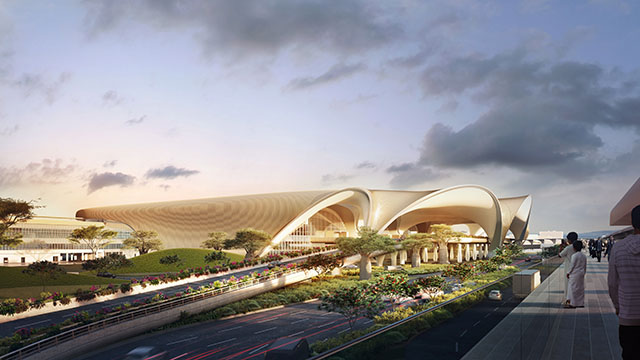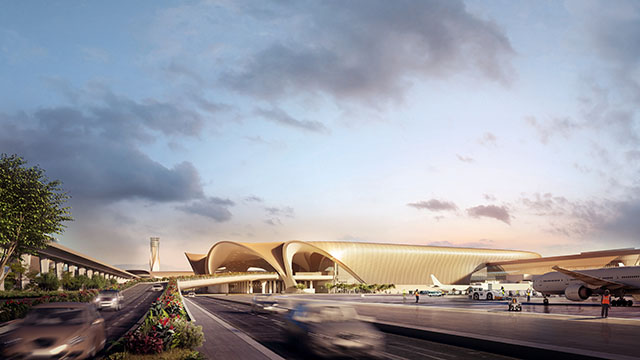Media Release
Mumbai, Sep 16: As Navi Mumbai International Airport (NMIA) prepares for its grand inauguration at the end of September, Maharashtra readies itself for a transformation. Beyond easing the load on Mumbai’s crowded skies, the airport is poised to fuel economic growth, attract investments, and trigger a wave of infrastructure development across the state.
When the first flights take off from the newly built NMIA later this year, it will mark more than just the opening of an airport. It will herald the arrival of Maharashtra’s next economic engine.


For decades, Chhatrapati Shivaji Maharaj International Airport (CSMIA) in Mumbai has shouldered the brunt of the region’s growing civil aviation needs, operating near capacity and managing under constrained land area. NMIA, with its sprawling design, modern facilities and strategic positioning, promises to reimagine Navi Mumbai’s future as a hub of commerce, logistics and connectivity.
A growth multiplier for Maharashtra’s economy
The economic potential of NMIA stretches far beyond ticket counters and baggage belts. According to estimates, the airport is expected to handle 90 million passengers annually, once fully operational. The figure is nearly double the current capacity of Mumbai’s existing airport. This influx will translate into thousands of new jobs: from ground staff to hospitality, logistics to retail.
The multiplier effect is significant. A recent report by the International Air Transport Association (IATA) suggests that every 1 per cent growth in air connectivity boosts GDP (Gross Domestic Product) by 0.5 per cent. With NMIA set to integrate Navi Mumbai into global flight paths, Maharashtra’s GDP could see a sizable uplift in the coming decade.
Additionally, the airport will make Navi Mumbai a magnet for investments. The surrounding Navi Mumbai Airport Influence Notified Area (NAINA)—a planned smart city—has been earmarked for real estate, warehousing, IT (Information Technology) parks, and commercial developments. Experts predict this region could attract billions in FDI (Foreign Direct Investments) and private investments, positioning Navi Mumbai as a rival to established central business districts in Mumbai like BKC and Lower Parel.
Strengthening Maharashtra’s infrastructure backbone
Equally transformative is the airport’s role as an infrastructure catalyst. NMIA is not an isolated project; it is being woven into a web of expressways, metro lines, and freight corridors that will knit Navi Mumbai tightly into the economic fabric of the state.
Key infrastructure enablers include:
- Mumbai Trans Harbour Link (MTHL): Slated to be India’s longest sea bridge, MTHL will connect South Mumbai directly to Navi Mumbai in under 30 minutes. With the airport as a critical endpoint, this corridor will supercharge both passenger and cargo flows.
- Metro and Suburban Rail Links: The upcoming Navi Mumbai Metro, alongside enhanced rail connectivity, will provide seamless last-mile access for commuters and airport employees.
- Dedicated Freight Corridors: NMIA’s cargo facilities are being positioned as a logistics powerhouse, connecting Maharashtra’s industrial clusters in Pune, Nagpur and Aurangabad directly to global trade networks.
Together, these initiatives promise to integrate NMIA into a multi-modal transport ecosystem. This development push aims to reduce travel times, cut logistics costs and improve efficiency across industries.
Spurring real estate and urban growth
Perhaps the most visible impact of the airport is already unfolding on Navi Mumbai’s skyline. Property developers are racing to capitalise on what they see as the city’s defining growth moment. From Panvel to Ulwe, where NMIA is located, residential and commercial projects are mushrooming, with prices appreciating by as much as up to 30 per cent in the past three years.
Urban planners envision Navi Mumbai evolving into a balanced twin city to Mumbai—one that eases the burden on the financial capital while offering modern infrastructure, affordable housing, and superior quality of life. The airport is the keystone in this urban transformation, much like Indira Gandhi International (IGI) spurred Gurugram’s rise near Delhi or Kempegowda International propelled North Bengaluru.
A boon for tourism and trade
NMIA is also expected to be a gateway to Maharashtra’s vast tourism potential. With improved international connectivity, destinations like the Konkan coast, Ajanta-Ellora caves and the hill stations of Western Ghats will become more accessible to global travellers.
On the trade front, the airport’s state-of-the-art cargo terminals will bolster Maharashtra’s role as a manufacturing and export hub. Sectors such as pharmaceuticals, textiles, agriculture and engineering are likely to benefit from faster, more efficient access to global markets.
Balancing growth with sustainability
While the economic and infrastructure dividends are clear, NMIA has also been designed with sustainability in mind. The airport incorporates green building standards, rainwater harvesting, solar power and noise-reduction technologies. Planners say the intent is to ensure growth does not come at the cost of ecological balance—a critical concern in a state grappling with urban pressures.
A defining moment for Maharashtra
The inauguration of NMIA is more than just a ribbon-cutting ceremony; it is a strategic inflection point for Maharashtra. It signals the state’s intent to create new engines of growth beyond traditional centres, to harness the power of connectivity for inclusive development and to invest in world-class infrastructure that can keep pace with aspirations.
For Navi Mumbai, it is the beginning of a long-awaited transformation—from a satellite township into a self-sustaining metropolis with global stature. For Maharashtra, it is the opening of a new economic frontier.
As planes take off in the coming months, both at home and abroad, they will carry more than passengers; they will carry the promise of a future where Navi Mumbai is no longer in Mumbai’s shadow but shines in its own right as a beacon of Viksit Bharat.